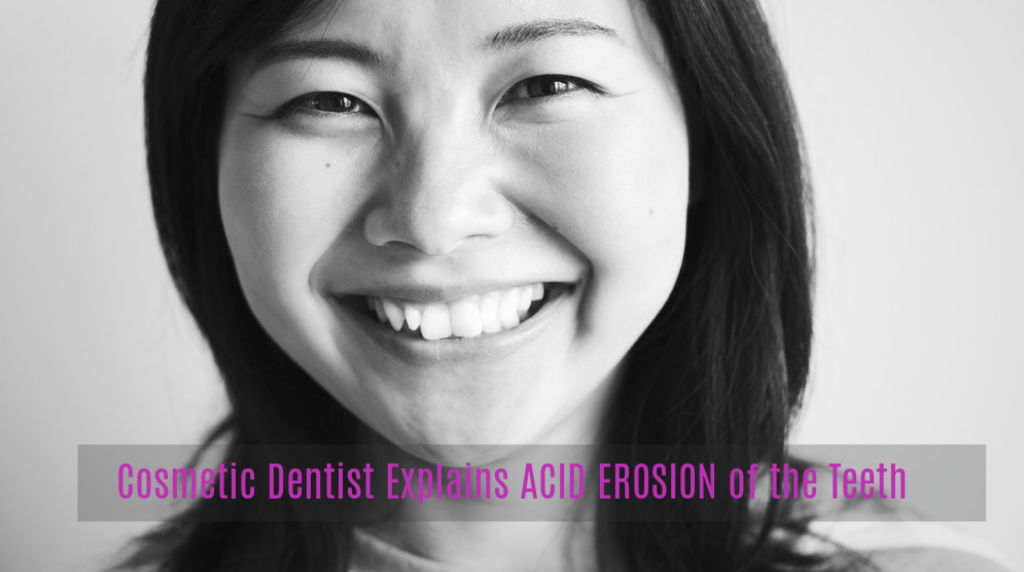Have you seen the toothpaste ads warning you about acid erosion? Today, we will explain precisely what that concept means–and why it’s so harmful to your teeth. Later, we will explore some ways a cosmetic dentist can help you prevent further erosion.
Anytime we talk about the tooth, we are referring to the parts that make its anatomy. The crown, pulp, gum line, dentin, root, and enamel are all parts of a tooth. The enamel is the thin but tough shell that covers the crown, the visible part of the tooth. That enamel is the toughest part of the tooth. In fact, it is the hardest tissue in the human body–harder than bones.
The tough enamel is made to protect the rest of your tooth from the strain of biting, chewing, grinding, crunching, and the harshness of chemicals and high temperatures. Despite its toughness, however, the enamel can be subject to cracking and wear from the same actions and substances that it protects the tooth from.
Forms and causes of enamel erosion
When you visit your dentist, she may explain the origins of enamel erosion in these professional terms.
- Abrasion is the wear and tear that comes with rough teeth brushing, incorrect flossing, biting on tough objects such as pencils, or chewing substances like tobacco.
- Attrition refers to the mutual friction that teeth cause on each other when you grind or clench. An excellent example of attrition is the involuntary teeth grinding during sleep and professionally referred to as bruxism.
- Abfraction reflects in trauma fractures such as cracks.
- Corrosion or acid erosion is caused by acids from food, medication such as aspirin and vitamin C, Gastroesophageal Reflux Disease commonly referred to as GERD, alcohol, and frequent vomiting in people with bulimia among many other causes.
These forms of enamel erosion will cause symptoms such as tooth discoloration, indentations, increased sensitivity, cracks, and chips. We make specific focus to corrosion caused by highly acidic foods.
Foods and beverages that cause acid erosion of your teeth
Foods and drinks that are high in acids eat away from your enamel. The American Dental Association gives them in the order of most acidic as listed:
- Lemon juice
- Sodas
- Powdered fruit drinks
- Sports drink
- Flavored teas
- Flavored water
- Apple juice
- Orange juice
Other acidic foods and beverages, in no particular order, include:
- Sweets and candies
- Wine
- Pickles
- Grapefruits
- Cranberries
- Tomato products including pasta sauce, salsa, ketchup, and hot sauce
- Coffee
The list of acidic foods is endless. Note that even though not food, aspirin is widely used as a painkiller and is also highly acid for your teeth.
How to stop/lessen tooth erosion
Paradoxically, the culpable highly acidic foods listed above are recommended from a different nutritional and health perspective. For example, lemon juice is rich in vitamin C and advised as a phlegm-reducing agent for cold. Similarly, among the health benefits listed for cranberries is their role in preventing gum disease due to their antimicrobial and anti-inflammatory properties.
How then do we reap the nutrition and health benefits of these foods while avoiding their acidic action on teeth? Here are a few recommendations.
- Eat acidic foods with water to minimize their acidic level or with high pH level foods such as nuts, mangos, melons, cheese, bananas, eggs, fish, vegetables, and whole grains among others.
- Consume acidic foods at mealtime (not snack times) to reduce acid attacks on your enamel.
- Wait for an hour before brushing teeth when you have consumed acidic foods. This gives your teeth time to eliminate the acids naturally.
- Brush your teeth the very last thing before bed and one other time during the day with fluoride toothpaste to strengthen your enamel and floss to remove plaque.
- Avoid holding or swishing acid drinks in your mouth. Instead, sip and swallow or use a straw.
- Swish your mouth with some water after consuming acidic foods and beverages. Drinking milk or snacking on cheese can help neutralize acids.
- Saliva controls acidic levels in your mouth. Help your saliva flow by chewing sugarless gum after you’ve taken acidic foods or beverages.
- Visit your dentist regularly for checkup and professional advice on tooth care.
Is acid erosion repairable?
Once acids consume your enamel, it cannot be regenerated naturally. Nevertheless, tooth erosion can be repaired using a remineralizing toothpaste to replenish calcium.
Additionally, a cosmetic dentist may also perform specific procedures to protect or replace lost enamel with artificial options. These include placing a cement-like material to cover the damage (bonding), cementing tooth-colored porcelain to the surface of your tooth (veneers), and applying caps to cover your damaged tooth completely (crowns).
So, when it comes to enamel erosion, prevention is always better than cure. But when it’s too late for preventing enamel erosion, reach out to a cosmetic dentist to schedule a consultation and stop further damage.

